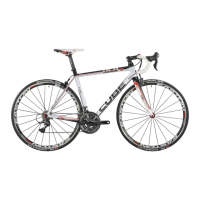7.1.3 Check tyres
Risk of Personal Injury and Material
Damage!
Does not apply to tubeless tyres.
In the event of angled valve the base of
the valve can rip o when riding which
causes sudden loss of tyre pressure.
This can lead to hazardous riding situ-
ations, falling, accidents and material
damage.
•
Have the tyre seating corrected by a specia-
list workshop.
You can undertake this job yourself if you
are familiar with tting and removing the
road wheels (see Chapter 11.1) and replacing
the tyre and tube
•
Remove the valve nut.
•
Check the valve position:
The valves must point directly towards the
centre axis of the road wheel.
The valves must point directly towards the centre
axis of the road wheel.
Risk of Personal Injury and Material
Damage!
Too low a tyre pressure leads to increa-
sed likelihood of punctures but mostly
dangerous handling.
The tyre can come o the rim on bends
and cause wandering of the tyre on the
rim.
This can lead to hazardous riding situ-
ations, falling, accidents and material
damage.
•
Inate your tyres to the correct pressure.
Check the tyre pressure:
1. Determine your tyre type
Mountain bikes can be tted with racing bike type
tyres and racing bikes with trekking tyres.
Rule of thumb:
Mountain bike tyres: Tyre width greater
than 40 mm Trekking / Cross-country and
Fitness bike tires: Tyre width from
28 mm – 40 mm Racing bike style tyres:
Tyre width less than 28 m Consult your
dealer to determine your tyre type.
Pressures:
• Mountainbiketyres:2.5–3.5barr
• Trekkingbiketyres:3,5-5,0bar
• Racingbiketyre:6,0-10,0bar
• Forthecorrectairpressureforcategories
not listed here, please refer to the infor-
mation on the tire or consult your dealer.
Valve does not point to the traversing wheel
centre

